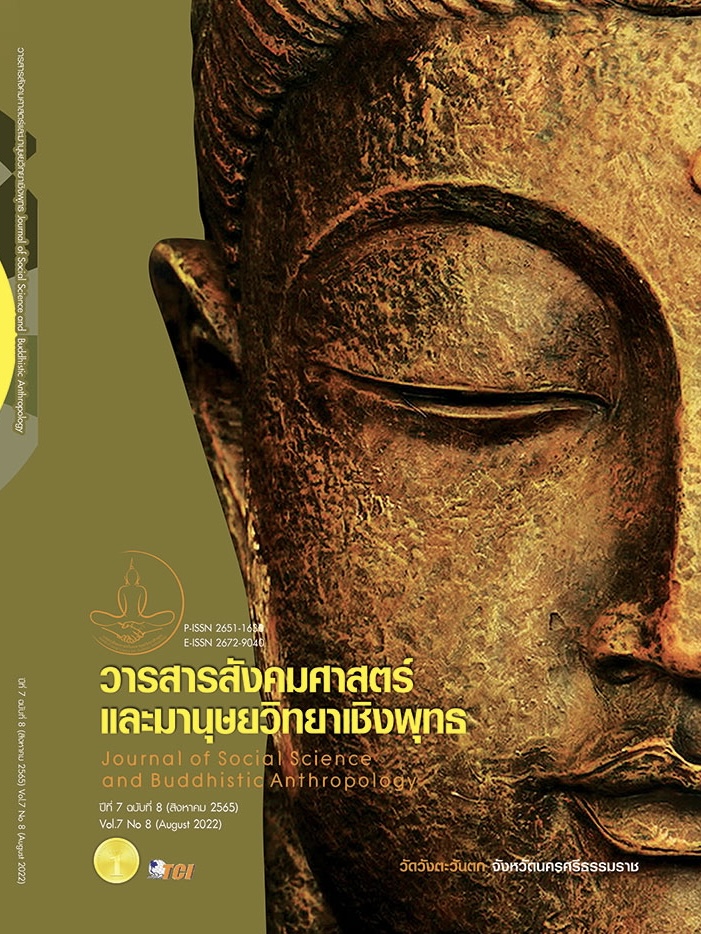WORK SAFETY, OPERATIONAL CLIMATE, AND WORK-LIFE BALANCE OF FOOD INDUSTRIAL FACTORY EMPLOYEES IN PATHUMTHANI PROVINCE
Keywords:
Work Safety, operational climate, Work-Life BalanceAbstract
The objectives of this research article were to 1) the levels of work safety, operational climate, and work-life balance of food industrial factory employees in Pathumthani Province., 2) the effects of work safety and operational climate on work-life balance of food industrial factory employees in Pathumthani Province. The quantitative research method with questionnaires as tools. The population are employees working in food industrial factories in Pathumthani Province, a total of 376 factories. Sampling from 193 factories, a sample of 385 subjects, using simple sampling. Data was analyzed with frequency, percentage, mean and multiple regression analysis. The results revealed that: 1) the levels of work safety, operational climate and work-life balance of food industrial factory employees in Pathumthani Province., in all aspects was at a high level, with work safety as the highest significant level, followed by operational climate and work-life balance at the average of 3.89, 3.87, 3.85 respectively; 2) the effects of work safety and operational climate on work-life balance of food industrial factory employees in Pathumthani province, effect forecasted a positive Standardized Coefficients. Work safety (β = 0.444, p-value = .000), operational climate (β = 0.511, p-value = .000) effected work-life balance of food industrial factory employees in Pathumthani province. about Leader's behavior, internal management, working standard reasonable compensation and good working environment. Forecasting results obtained a positive multiple correlation coefficient (R) of .898, a forecast coefficient (R2) of .806, a forecast value of 80.6%, with the statistically significant level at 0.01.
References
ฐานิตตา สิงห์ลอ. (2563). ความสมดุลในชีวิตการทำงานของพนักงานการประปาส่วนภูมิภาค เขต 3. ใน วิทยานิพนธ์บริหารธุรกิจมหาบัณฑิต, สาขาวิชาบริหารธุรกิจมหาบัณฑิต. มหาวิทยาลัยศิลปากร.
สมชัย ปราบรัตน์. (2561). ความสมดุลของชีวิตและทำงานของพนักงาน ในธุรกิจอุตสาหกรรมการผลิตประเภทอาหารแปรรูปบรรจุกระป๋อง: กรณีศึกษาเฉพาะ 3 บริษัทขนาดใหญ่ในจังหวัดสงขลา. ใน เอกสารการประชุมหาดใหญ่วิชาการระดับชาติและนานาชาติครั้งที่ 9, วันที่ 20 กรกฎาคม 2561 ณ ห้องประชุม Blue Ocean Hall อาคารคณะบริหารธุรกิจ มหาวิทยาลัยหาดใหญ่. มหาวิทยาลัยหาดใหญ่.
สยามรัฐ. (2562). Pathum Thani Food Innopolis. เรียกใช้เมื่อ 20 ธันวาคม 2563 จาก https://siamrath.co.th
สำนักงานอุตสาหกรรมจังหวัดปทุมธานี. (2563). รายงานสภาวะเศรษฐกิจอุตสาหกรรม ราย 6 เดือนปี 2563 (มกราคม – มิถุนายน 2563) สำนักงานอุตสาหกรรมจังหวัดปทุมธานี. เรียกใช้เมื่อ 20 ธันวาคม 2563 จาก http://old.industry.go.th /pathumthani /index.php
. (2563). รายงานสภาวะเศรษฐกิจอุตสาหกรรม.(กรกฎาคม - ธันวาคม, 2563). เรียกใช้เมื่อ 30 กรกฎาคม 2563 จาก https://pathumthani.industry.go.th/th
Burke, W. W. & Litwin, G. H. (1992). A causal model of organizational performance and change. Journal of Management, 18(3), 523-545.
Byrne, D. (2005). Complexity, Configurations and Cases. Theory, Culture & Society, 22(5), 95-111.
Cochran, W. G. (1977). Sampling Techniques. 3rd Edition. New York: John Wiley & Sons.
Cooper, M. D. & Phillips, R. A. (2004). Exploratory Analysis of the Safety Climate and Safety Behavior Relationship. Journal of Safety Research, 35(5), 497-512.
Cronbach, L. J. (1951). Coefficient alpha and the internal structure of tests. Psychometrika, 16(3), 297-334.
Dolan, P. et al. (2008). Do we really know what makes us happy? A review of the economic literature on the factors associated with subjective well-being. Journal of Economic Psychology, 29(1), 94-122.
Duxbury, C. et al. (2003). Complex domain onset detection for musical signals. Retrieved June 1 , 2021, from http://citeseerx.ist.psu.edu/viewdoc/ download?doi=10.1.1.57.9197&rep=rep1&type=pdf
Ercan, S. & Buyukyilmaz, O. (2016). The Effect of Organizational Climate on Work Life Balance. International Journal of Research in Commerce it & Management, 6(4), 76-80.
Forehand, G. A. & Haller, V. G. (1964). Environmental variation in studies of organizational behavior. Psychological Bulletin, 62(6), 361-382.
Forsthy, S. & Polzer-Debruyne, A. (2007). The organizational pay-offs for perceived work–life balance support. Asia Pacific Journal of Human Resources, 45(1), 113-123.
Huang, Y.-H. et al. (2006). Safety climate and self-reported injury: Assessing the mediating role of employee safety control. Accident Analysis & Prevention, 38(3), 425-433.
Kline, R. B. (2005). Principles and practice of structural equation modeling. 2nd Edition. New York: Guilford Press.
Silva, S. et al. (2004). OSCI: an organizational and safety climate inventory. Safety Science, 42(3), 205-220.
Slocum, J. W. & Hellriegel, D. (2011). Principles of Organizational Behavior. (13th ed.). Mason: OH: South-Western Cengage Learning.
Tomazevic, N. et al. (2014). The Consequences of a Work-Family (Im) balance: From the Point of View of Employers and Employees. International Business Research, 7(8), 83-100.
UNCTAD. (2020). Technical Note Global trade impact of the Coronavirus (COVID-19). Retrieved June 1-5, 2021, from https://unctad.org/en/PublicationsLibrary/ ditcinf2020d1.pdf
Vasumathi, A. (2018). Work life balance of women employees: a literature review. International Journal of Services and Operations Management, 29(1), 100-146.
Yamane, T. (1973). Statistics: An Introductory Analysis. 3rd Edition. New York: Harper and Row.
Zohar, D. (2010). Thirty years of safety climate research: reflections and future directions. Accid. Anal. Prev, 42(5), 1517-22.
Downloads
Published
How to Cite
Issue
Section
License
Copyright (c) 2022 Journal of Social Science and Buddhistic Anthropology

This work is licensed under a Creative Commons Attribution-NonCommercial-NoDerivatives 4.0 International License.








